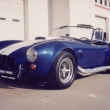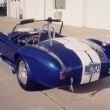1967 Shelby 427 Cobra
The Cobra 427 has its roots very firmly planted in the British company A.C.’s open topped sports car, the Ace. The tubular frame Ace was introduced in 1954 with all independent suspension designed by John Tojeiro. In 1963, Carroll Shelby, Cobra’s founder, adopted this car and developed it with disc brakes all around a 4.7 litre Ford engine which delivered 330 bhp. In 1966 the larger Cobra 427, with its 7 litre Ford engine, was added to the range.
Shelby wanted to build a car with a chassis from England and an engine from the USA. With this idea in mind, he became acquainted with the late Charles Hurlock and his nephew Derek, who ran A.C. Cars of Thames Ditton in Surrey, England. A.C. had just lost their suppliers of 6 cylinder Bristol engines for the Ace, and Shelby offered to continue paying them to produce the Ace chassis for his own sports car, to which he would add an American V8 engine and gearbox. A.C. provisionally accepted his offer as long as a suitable engine could be found. Shelby’s proposal took a step closer to fruition in October 1961 when Ford introduced their 221 ci small block engine. Shelby contacted Ford with regard to his idea and the possibility of acquiring this engine and Ford expressed a serious interest in his project.
The first Ace chassis arrived in the USA in February 1962. Shelby installed a 260 ci HiPo engine and Borg-Warner four speed gearbox, and the first AC Cobra was created. This may have been the first, but the prototype Cobra, designated the CSX 2000, made its debut at the New York Auto Show in April 1962. The CSX 2000 appeared on the Ford stand where it attracted a lot of attention and dealers started placing orders. Shelby committed himself full time to his Cobra project and more chassis were shipped from A.C. Cars. The company was, however, having teething problems. The chassis needed extensive upgrades and alterations and Shelby could not build them fast enough. The prototype CSX 2000 was constantly painted different colors for magazine reviews to give the impression of a substantial quantity of cars being produced.
The Cobra was given its Federation Internationale de L’Automobile classification as a GT III car in August 1962. This meant the car could compete in the over two litre class of the FIA Manufacturer Championship. The FIA rules stated a minimum of 100 units had to be completed to meet this standard, but the Cobra was given this classification even though only eight cars were completed. The Cobra’s first FIA race was the Los Angeles Grand Prix on October 13, 1962, and it was driven by Bill Krause. Krause drove a good race and led for a time until the rear hub broke and he had to retire. For Riverside, January 1963, the rear hubs were strengthened and two Cobras, driven by Dave MacDonald and Ken Miles, were entered. MacDonald came in first and Miles second, well ahead of the Corvettes, their nearest rivals.
Shelby ran his first Le Mans 24 hours in a Cobra in 1963. Ford refused to provide him with an engine so, with the help of A.C. Cars and Ed Hugus, Shelby prepared his own cars, one for himself to drive and one for Hugus to drive. The fastest Cobra managed to finish an extremely respectable 7th. Cobra’s impressive race history continued at the Bridgehampton 500 km race in September 1963 where Dan Gurney drove a Cobra to victory and in doing so, he became the first American driver to win an FIA race in an American car. The Shelby Cobras returned to the LeMans 24 our race in 1964 and completely eclipsed the previous years results by finishing fourth and first in the GT section, defeating the dominant Ferraris.
The prototype of the new version of the car, the Cobra 427 was built in November 1964 and the official press launch was in January 1965 at the Riverside International Raceway. The Cobra 427 had a new tubular coil spring chassis created by Ford engineer Klaus Arning, who, basing his ideas on the design of the original Ace, developed a suitable platform for the higher power of the big block Cobra. The bodywork was also modernized giving it a much more macho appearance with flared arches. The Cobra 427 was capable of incredible speed, going from 0-100-0 in less than thirteen seconds. Production began in April 1965 but ground to a halt in March 1967 after approximately 160 road cars had been built, one of which was the Cobra 427 in the Mathews Collection, an excellent example that has never been raced.

